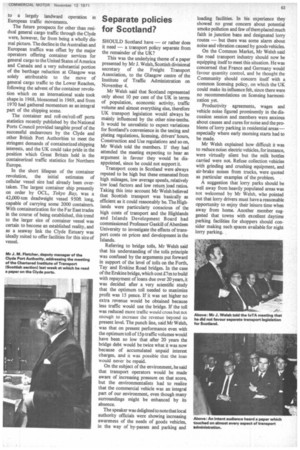Separate policies for Scotland?
Page 65

If you've noticed an error in this article please click here to report it so we can fix it.
SHOULD Scotland have — or rather does it need — a transport policy separate from the remainder of the UK?
This was the underlying theme of a paper presented by Mr J. Welsh, Scottish divisional
secretary of the Freight Transport Association, to the Glasgow centre of the Institute of Traffic Administration on November 4.
Mr Welsh said that Scotland represented only about 10 per cent of the UK in terms of population, economic activity, traffic volume and almost everything else, therefore UK transport legislation would always be mainly influenced by the other nine-tenths.
It would be unrealistic to expect variations for Scotland's convenience in the testing and plating regulations, licensing, drivers' hours, Construction and Use regulations and so on, Mr Welsh told the members. If they had attended the meeting expecting to hear an argument in favour they would be disappointed, since he could not support it.
Transport costs in Scotland were always reputed to be high but these emanated from high mileages, low average speeds, relatively low load factors and low return load ratios. Taking this into account Mr Welsh believed that Scottish transport was basically as efficient as it could reasonably be. The High lands were particularly conscious of the high costs of transport and the Highlands and Islands Development Board had commissioned Professor Gaskill of Aberdeen University to investigate the effects of transport costs on prices and development in the Islands.
Referring to bridge tolls, Mr Welsh said that his understanding of the tolls principle was confused by the arguments put forward in support of the level of tolls on the Forth, Tay and Erskine Road bridges. In the case of the Erskine bridge, which cost Om to build with repayment of loans due over 20 years, it was decided after a very scientific study that the optimum toll needed to maximize
profit was 15 pence. If it was set higher no extra revenue would be obtained because
less traffic would use the bridge. If the toll was reduced more traffic would cross but not enough to increase the revenue beyond its present level. The punch line, said Mr Welsh, was that on present performance even with the optimum toll of 15p traffic volumes would have been so low that after 20 years the bridge debt would be twice what it was now because of accumulated unpaid interest charges, and it was possible that the loan would never be repaid.
On the subject of the environment, he said that transport operators would be made aware of increasing pressure on that score, but the environmentalists had to realize that the commercial vehicle was an integral part of our environment, even though many surroundings might be enhanced by its absence.
The speaker was delighted to note that local authority officials were showing increasing awareness of the needs of goods vehicles, in the way of by-passes and parking and loading facilities. In his experience they showed no great concern about potential smoke pollution and few of them placed much faith in junction bans and designated lorry routes — but there was some alarm about noise and vibration caused by goods vehicles. On the Common Market, Mr Welsh said the road transport industry should now be equipping itself to meet this situation. He was concerned that France and Germany would favour quantity control. and he thought the Community should concern itself with a common licensing policy, on which the UK could make its influence felt, since there were no recommendations on licensing harmonization yet.
Productivity agreements, wages and vehicle noise figured prominently in the dis cussion session and members were anxious about causes and cures for noise and the problems of lorry parking in residential areas— especially where early morning starts had to be made.
Mr Welsh explained how difficult it was to reduce noise: electric vehicles, for instance, were virtually silent but the milk bottles carried were not. Refuse collection vehicles with grinding and crushing equipment, and air-brake noises from trucks, were quoted as particular examples of the problem.
A suggestion that lorry parks should be well away from heavily populated areas was not welcomed by Mr Welsh, who pointed out that lorry drivers must have a reasonable opportunity to enjoy their leisure time when away from home. Another member suggested that towns with excellent daytime parking facilities for shoppers should consider making such spaces available for night lorry parking.










































































































































































































